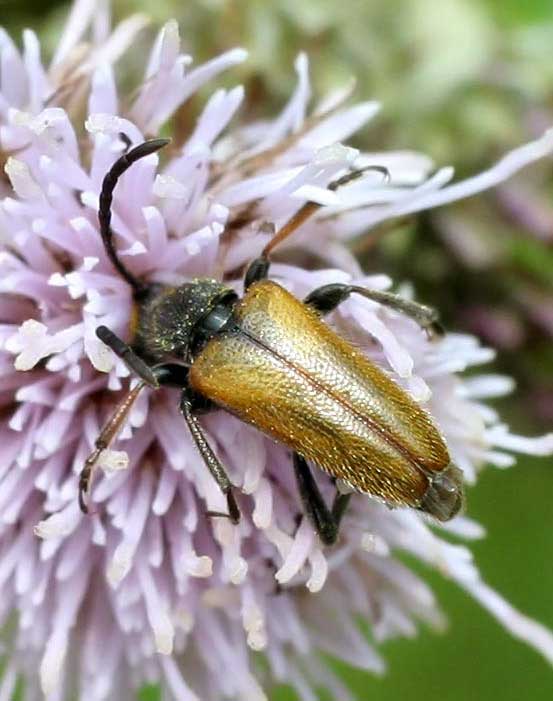
Pseudovadonia livida (©Entomart.)
Superregnum: Eukaryota
Cladus: Unikonta
Cladus: Opisthokonta
Cladus: Holozoa
Regnum: Animalia
Subregnum: Eumetazoa
Cladus: Bilateria
Cladus: Nephrozoa
Cladus: Protostomia
Cladus: Ecdysozoa
Cladus: Panarthropoda
Phylum: Arthropoda
Subphylum: Hexapoda
Classis: Insecta
Cladus: Dicondylia
Subclassis: Pterygota
Cladus: Metapterygota
Infraclassis: Neoptera
Cladus: Eumetabola
Cladus: Endopterygota
Superordo: Coleopterida
Ordo: Coleoptera
Subordo: Polyphaga
Infraordo: Cucujiformia
Cladus: Phytophaga
Superfamilia: Chrysomeloidea
Familia: Cerambycidae
Subfamilia: Lepturinae
Tribus: Lepturini
Genus: Pseudovadonia
Species: Pseudovadonia livida
Name
Pseudovadonia livida Fabricius, 1776
References
Tribe Lepturini: Pseudovadonia livida (F., 1776) - photo by D.G. Kasatkin
Özdikmen, H.; Turgut, S. 2009: A review on the genera Pseudovadonia Lobanov et al., 1981 and Vadonia Mulsant, 1863 (Coleoptera: Cerambycidae: Lepturinae). Munis entomology & zoology, 4: 29–52. [1]
Vernacular names
magyar: Barnás virágcincér
Pseudovadonia livida, the fairy-ring longhorn beetle, is a beetle species of flower longhorns belonging to the family Cerambycidae, subfamily Lepturinae.[1]
Subspecies
Subspecies include:[2]
Pseudovadonia livida bicarinata (Arnold, 1869)
Pseudovadonia livida desbrochersi (Pic, 1891)
Pseudovadonia livida hatayensis Özdikmen, 2015
Pseudovadonia livida livida (Fabricius, 1776)
Pseudovadonia livida pecta (J. Daniel & K. Daniel, 1891)
Pseudovadonia livida setosa Danilevsky, 2013
Distribution
This beetle is widespread in most of Europe, in the eastern Palearctic realm, and in the Near East (Armenia, Azerbaijan, Belarus, Belgium, Bulgaria, China, Czech Republic (Bohemia, Moravia), Estonia, France, Georgia, Germany, Greece, Iran, Italy, Kazakhstan, Kyrgyzstan, Latvia, Lithuania, Luxembourg, Moldova, Netherlands, Poland, Portugal, Romania, Russia, Sicily, Slovakia, Spain, Turkey, Ukraine, and the United Kingdom).[3]
Habitat
This species mainly inhabits pine forests, but they are also present in deciduous trees (Quercus and Castanea species.[4]
Description
The adults of Pseudovadonia livida grow up to 5–9 millimetres (0.20–0.35 in). These small beetles are robust and have a broad head with large eyes, dense puncturation and erect pubescence. The antennae are black and robust, slightly shorter than the body. Pronotum is quadrate and shiny black, with shallow puncturation on the surface. Also the scutellum is shining black. Elytra are reddish-brown with darker suture. Shoulders are much wider than the base of the pronotum. They are covered with fine semi-erect golden hair.[5][4]
Biology
Adults can be encountered from May through September, completing their life cycle in two years. They are very common flower-visitors, especially Apiaceae species, feeding on pollen and the nectar. Larvae do not develop in dead wood, as usual in many species of Cerambycidae, but in humus infested by fungus Marasmius oreades, feeding on mycelium.[5]
References
Invertebrated on line
Biolib
Fauna europaea
Website of the Watford Coleoptera Group
Cerambyx
Ehnström, B. og Holmer, M. 2007. Nationalnyckeln till Sveriges flora och fauna. Skalbaggar: Långhorningar. Coleoptera: Cerambycidae. ArtDatabanken SLU, Uppsala. 298 sider. ISBN 978-91-88506-62-7
Retrieved from "http://en.wikipedia.org/"
All text is available under the terms of the GNU Free Documentation License

